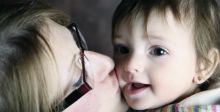Internal mini form
Contact Us Today
Dysphagia is a severe condition that requires vigilant monitoring and, in the presence of complications, immediate and aggressive treatment. Like so many other aspects of parenting a child with Cerebral Palsy, managing symptoms will help a child to remain healthy and thrive.
Dysphagia makes it difficult to swallow
A child with Cerebral Palsy will likely face a number of health concerns during his or her lifetime. One of the most common – and the most vexing in terms of management – is dysphagia.
Commonly referred to as oral-motor dysfunction, dysphagia is more common among children with moderate to severe cases of Cerebral Palsy. It’s a dangerous condition that, if left mismanaged, can cause numerous life-threatening consequences, up to and including death – primarily due to the ability to block a person’s airway. For that reason, dysphagia must be vigilantly monitored by parents, caretakers and medical professionals.
Like other conditions associated with Cerebral Palsy, dysphagia can range from moderate to severe; the form of the condition is dependent on the scope and nature of a child’s brain injury. And, unfortunately, it’s a condition that might not present itself to parents in an obvious way.
Today, there are several strategies that parents can use to help prevent complications that can arise from oral-motor dysfunction. Those include everything from dietary changes to surgery.
What is dysphagia?
Dysphagia is the medical term for difficult swallowing. Typically, if a person has the condition, it’s because the esophagus cannot move food and liquids from the back of a child’s mouth to the stomach. The muscle coordination in the face and neck is a complex and intricate set of movements that allow a person to breath, swallow and talk. A person with Cerebral Palsy is prone to muscle impairment, even in the face and neck region.
Dysphagia can happen to anyone, but it’s a fairly common condition among children with Cerebral Palsy or other conditions that affect the central nervous system, or those that have endured brain injury. According to medical research, as many as 90 percent of children with Cerebral Palsy may show symptoms of dysphagia.
A child that has an occasional mishap while swallowing food or liquids may not have dysphagia, but if it happens regularly, it’s highly recommended that the child be evaluated for oral-motor dysfunction.
To a child or adult with dysphagia, it feels as though food is lodged in the esophagus before it either moves into the stomach, or is regurgitated. Some disclose that it feels as if the muscles of the neck and face work in the opposite direction than they are supposed to – effectively making the food move back up the system instead of down. For this reason, feeding time can become quite scary for a child, or adult, as they fear they cannot breathe and swallow at the same time.
There are two categories of dysphagia. They include:
- Oropharyngeal dysphagia – This form of dysphagia is the result of abnormalities in the muscles and nerves of the oral cavity, pharynx and esophageal sphincter. Oropharyngeal dysphagia is most often related to nerve and muscle malfunctions that weaken the throat muscles, thereby making it difficult to move food from the mouth to the throat.
- Esophageal dysphagia – This form of dysphagia is the result of the muscle malformations, or a malfunction of the lower esophageal sphincter, When this occurs it can cause motility issues; a feeling as though food is stuck in the esophagus.
Children with dysphagia endure a number of different symptoms of the condition, depending on the nature, and severity of their Cerebral Palsy. Some of these related symptoms are inconvenient or uncomfortable, but others are severe and must be monitored by caretakers and parents. Sometimes, dysphagia can cause problems unrelated to feeding; children with severe cases have difficulty speaking because their muscles cannot adequately control their vocal chords.
Speech-related signs of dysphagia include:
- Ataxic dysarthria – A slow and erratic pattern of speech caused by difficulty with muscular coordination and breathing.
- Flaccid dysarthria – A nasal speech caused by inability of the vocal chords to open and close correctly.
- Inability to voice – The muscles that control vocal chords are not properly coordinated.
- Lack of vocal articulation – The muscles of the face, jaw, mouth and tongue do not work in concert to provide the proper conventional speech coordination.
- Mixed dysarthria – A combination of several symptoms of dysarthria.
- Spastic dysarthria – A monotone speech with difficulty pronouncing individual syllables.
- Verbal apraxia – Signals sent from the brain that inform speech misfire. This severely effects a child’s ability to pronounce individual syllables properly.
The signs and symptoms of dysphagia that are directly related to feeding include:
- Apnea during feeding – when a person falls asleep during feeding.
- Aspiration – when food penetrates the larynx and enters the airway below the vocal folds. Aspiration can occur in several ways.
- Delayed or absent swallowing reflex – when the swallowing reflex misfires and the food rolls into the pharynx, the airway remains open, and food is at risk of falling into the airway before the reflex actually triggers.
- Difficulty in or an unwillingness to feed.
- Esophageal spasms – squeezing of the esophagus.
- Globus sensation – the feeling of having an obstruction in the throat.
- Odynophagia – showing signs of pain while swallowing.
- Oral apraxia – inability to make movements of the mouth, such as opening or closing.
- Physical reactions while feeding, such as frowning.
What causes dysphagia?
Dysphagia has several root causes, which include aging, stroke, traumatic head injury, or acid reflux disease, narrowing of the esophagus, and congenital abnormalities. But for children with Cerebral Palsy, the cause is often found in the initial brain injury that caused Cerebral Palsy.
Depending on the nature of a child’s brain injury, his or her symptoms could be oropharyngeal (rooted in the mouth or pharynx), or esophageal (rooted in the esophagus).
Children with spastic Cerebral Palsy are especially vulnerable to dysphagia because spasticity can cause contractions of the esophagus that are uncontrolled.
What are some of the indicators that a child has dysphagia?
Difficulty swallowing is not always easy to discover. If a child has a mild case of dysphagia, occasional incidents of coughing or regurgitation may seem like isolated incidents. When it happens, a parent may assume that a child consumed something that didn’t agree with him or her. The signals that a child has dysphagia are also identified with other, less-severe conditions. Heartburn can be considered a consequence of a child’s diet, and resistance to feeding may appear at first glance to be the result of a picky eater.
But if a child has Cerebral Palsy – even a mild case – it’s a good idea to ask physicians to diagnose or rule-out dysphagia because the consequences of not following up can be life-threatening.
Some of the indicators that a child may be having trouble swallowing include:
- Back pain
- Chest pain
- Choking
- Constant cough
- Drooling
- Dry mouth
- Fatigue
- Heartburn
- Nasal regurgitation
- Resistance to feeding
- Sluggishness, lack of energy
- Sore throat
- Taking a long time to eat
- Tongue thrust
- Unexplained weight loss
How is dysphagia diagnosed?
Physicians use a number of means to diagnose dysphagia. After a parent notices that a child is not swallowing properly, a physician will likely inquire about a child’s physical symptoms.
The physician will review a child’s medical history and conduct a physical examination.
During this assessment, a physician will examine:
- Muscle condition
- Neurological condition
- Throat and mouth
A number of tests may also be conducted to determine what malfunctions are occurring during the process of swallowing. These tests will help doctors determine what interventions are required to help a child swallow properly. Meal planning, timing, feeding processes, and consistency of food may be altered, as well. For some tests, a physician may refer a child to a medical speech pathologist, or a deglutologist.
The tests a physician may order include:
- Esophageal manometry – A test that uses a thin, flexible catheter to evaluate the function of the esophageal muscles, and whether a child is experiencing esophageal spasms.
- Esophageal acid testing – This test uses a thin catheter inserted through the nose and placed above the esophagus. The tip of the catheter detects acid levels, which are assessed via a recorder that is attached to the catheter. The test tells physicians whether a child has acid reflux, which is also common among children with moderate to severe Cerebral Palsy.
- Flexible endoscopic evaluation with sensory testing or endoscopy – By using a lighted fiber optic tube, a physician can observe the mouth, esophagus and stomach to find if any obstructions or dysfunctions exist, and determine the functionality of the swallow mechanisms.
- Ultrasound – A test that uses sound waves to identify problems in the esophagus and related tissues and muscles. The test identifies the muscle characteristics, including thickness.
- Videofluoroscopic swallow study or modified barium swallow study – A technician will view an X-ray of the swallowing process while a patient swallows food and liquids that contain barium. This allows a technician to identify and track activities in the esophagus and digestive tract. The test is particularly effective in determining what food consistencies work for patients.
What remedies are used to treat, or limit, the effects of dysphagia?
Most of us take the ability to swallow food and liquids for granted. However, the physical act of swallowing is a complex process that involves more than 50 muscles, thousands of nerves and several muscles to execute.
Because the act of swallowing is voluntary, its individual steps must be planned. Food must be chewed thoroughly to prepare to be swallowed and digested. All edibles must be transferred from the mouth, through the larynx and into the esophagus. Ensuring all of this occurs in a coordinated fashion is considered one of the body’s most intricate processes.
The number of byzantine mechanisms that come into play can lead to several medical complications, of which there are several potential remedies. Which ones physicians recommend is based on a child’s specific symptoms and overall physical health.
Though surgical interventions are a distinct possibility for children with severe problems swallowing, medical professionals will typically recommend some non-surgical treatments as a first step. Recommendations will be made after a practitioner has performed extensive tests to determine what’s happening in a child’s mouth, or in his or her esophagus.
Some of the non-surgical interventions physicians may recommend include:
- Change in food or liquid consistency – Sometimes, if foods are too solid, or if liquids are too thin, this can aggravate a child’s ability to swallow successfully. When this occurs, a physician may direct parents or caretakers to puree solid foods, or cut foods into smaller pieces to change its texture. Also, it may be recommended that children drink thicker (or thickened) liquids, which are generally easier to control once they’re in the mouth.
- Chin tucking – Sometimes, positioning helps a child to control mechanisms that affect swallowing. A tucked chin, for example, may be of helpful. This action prevents the likelihood that food will enter the trachea while swallowing.
- Encouraging chewing – Sometimes, children have a tendency to insufficiently chew their foods. When a child is undergoing speech and language, or occupational therapy, this topic may be covered.
- Muscle exercises – Specific exercises usually prescribed by medical speech and language pathologist can strengthen the muscles used in swallowing in order to improve strength and coordination.
A child will typically receive services to address dysphagia in a medical setting, although the information that is ascertained about a child’s condition may be used in therapeutic settings. A speech and language pathologist and/or a registered dietitian may be called upon to help a child improve swallowing and determine proper feeding and meal planning.
The places where a child may undergo treatment include:
- Acute care centers
- Clinics
- Hospitals
- In-home settings
- Long-term care facilities and nursing homes
- Physician’s offices
- Rehabilitation centers
In many cases, a child’s condition may be too severe to treat without more aggressive medical interventions. These interventions may include medications, therapies or, as a last resort, surgery including:
- Feeding tubes – If a child’s condition does not respond to dietary changes or non-surgical interventions, it may be necessary to install a feeding tube to make sure that a child receives all of the necessary nutrition needed to thrive. A feeding tube that passes into the stomach bypasses all of the functions of the mouth and esophagus, eliminating many of the challenges a child with dysphagia faces.
- Surgically excising the esophageal sphincter – If the sphincter is cut to relieve pressure caused when it cannot relax, it can help a child swallow food without regurgitating it.
- Surgically removing obstructions – If there’s a physical defect or obstruction on the pharynx of the esophagus, surgical intervention can address them. Strictures or rings – which can develop over time – can be removed endoscopically. In cases where larger openings are needed in the esophagus, a surgeon may insert a balloon that is inflated to make a wider opening.
Prognosis after treatment depends on the nature of his or her Cerebral Palsy and what types of difficulties he or she has experienced while swallowing. In some cases, there is a marked improvement. In others, parents will always have to monitor a child’s condition.
What are the risks of not treating dysphagia?
Not treating dysphagia, or properly managing the condition, can lead to a number of health consequences for a child, which is why if a parent has any indication that a swallowing issue exists, he or she must seek medical assistance.
Untreated dysphagia can lead to:
- Achalasia – This is a systematic narrowing of the esophagus due to the destruction of parasympathetic ganglia of the esophagus, causing inability of the lower esophageal sphincter to relax, open and pass food into the stomach.
- Aspiration or respiratory issues – Among the most serious concerns a parent will have for a child with Cerebral Palsy, aspiration occurs when fluids enter the lungs, leading to infection. This can cause a person to choke, or close off an airway. Any of these situations can be life-threatening for a child, especially one that is medically vulnerable.
- Dehydration – This condition persists when a person does not receive enough liquids to sustain life – they lose more fluids than they retain. If prolonged, dehydration can lead to a number of severe problems, including swelling of the brain, low blood volume shock, kidney failure, coma and, in severe cases, death.
- Malnutrition – If a child is experiencing swallowing issues, the symptoms cause so much pain and discomfort that a child may not want to eat food. This can be particularly troublesome for infants, who may not take a bottle or food because of how it makes them feel. As a child grows, it may be difficult to maintain a normal body weight or thrive because of the lack of nutrients consumed.
- Pneumonia – Chronic aspiration can lead to pneumonia, a severe infection of and inflammation to one or both lungs.
When treated properly, dysphagia is a condition that can be managed, but it’s something that must be evaluated, planned for and monitored properly.
How can I help my child cope with dysphagia?
Like many conditions associated with Cerebral Palsy, dysphagia can be difficult to cope with on a day-to-day basis. The fear of not being able to breath properly, or the sensation of food being blocked in the throat can cause anxiety about eating, every time a person is hungry. But there are several ways in conjunction with seeking treatment that a parent can employ to support a child who is coping with swallowing difficulty.
The first is to teach the child how to carefully enjoy their meals. Once a child reaches the age where he or she can pick and choose meals, a parent can indicate to a child that it’s important to eat slowly so the food can be enjoyed. This will help children that have developed ambivalence about eating understand that the troubles they have can be controlled in many cases. Likewise, understanding the dynamics of the feeding process will mean a parent is less likely to rush their child through feedings and understand the need for accommodating a slower pace.
If a child has a feeding tube, parents can tell the child that the tube is the gateway that makes it possible for them to participate in their activities. By helping children understand the role of the feeding tube, they are likely to feel less self-conscious about having one.
Parents are urged to meet with a speech and language pathologist and a registered dietitian to gain a thorough understanding of their child’s condition, and proper guidance and training on meal planning and preparation, dietary recommendations, positioning rituals, therapeutic exercises, and feeding techniques. The confidence gained will translate to an improved process that allows the child to reduce their anxiety when eating.

Associative conditions
Cerebral Palsy affects muscle tone, gross and fine motor functions, balance, coordination, and posture. These conditions are mainly orthopedic in nature and are considered primary conditions of Cerebral Palsy. There are associative conditions, like seizures and intellectual impairment that are common in individuals with Cerebral Palsy. And, there are co-mitigating factors that co-exist with Cerebral Palsy, but are unrelated to it. Understanding conditions commonly associated with Cerebral Palsy will enhance your ability to manage your child’s unique health concerns.
Associative Conditions
Common associative conditions
Click on a condition listed below to learn more.








